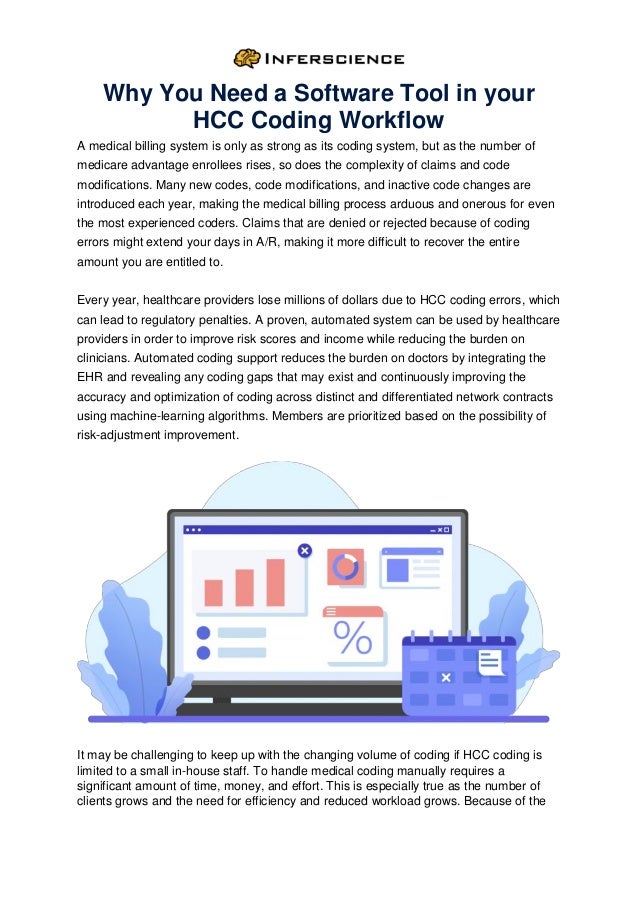
Why You Need a Software Tool in your HCC Coding Workflow
- 1. Why You Need a Software Tool in your HCC Coding Workflow A medical billing system is only as strong as its coding system, but as the number of medicare advantage enrollees rises, so does the complexity of claims and code modifications. Many new codes, code modifications, and inactive code changes are introduced each year, making the medical billing process arduous and onerous for even the most experienced coders. Claims that are denied or rejected because of coding errors might extend your days in A/R, making it more difficult to recover the entire amount you are entitled to. Every year, healthcare providers lose millions of dollars due to HCC coding errors, which can lead to regulatory penalties. A proven, automated system can be used by healthcare providers in order to improve risk scores and income while reducing the burden on clinicians. Automated coding support reduces the burden on doctors by integrating the EHR and revealing any coding gaps that may exist and continuously improving the accuracy and optimization of coding across distinct and differentiated network contracts using machine-learning algorithms. Members are prioritized based on the possibility of risk-adjustment improvement. It may be challenging to keep up with the changing volume of coding if HCC coding is limited to a small in-house staff. To handle medical coding manually requires a significant amount of time, money, and effort. This is especially true as the number of clients grows and the need for efficiency and reduced workload grows. Because of the
- 2. numerous benefits it provides, utilizing HCC Coding risk adjustment software becomes necessary. Some of the 3 key reasons why you need to include an HCC Coding Software in your workflow are: 1. Cost-Effectiveness The cost of hiring medical coders is high. There is a shortage of medical coders at the moment. As a result of the ICD-10, coders had to master the new system. Due to ICD 10’s deployment, many medical coders will be forced to retire as their average age reaches 54 in the near future. It is far more difficult to find qualified coders for specialty-specific coding. Depending on where you live, you may not be able to find medical coders that meet your demands. Even though qualified medical coders are scarce, their earnings are rising because of it. Programmers today have a plethora of professional paths to choose from, making it tough to keep them around. According to the AAPC, the average annual salary for a medical coder is $52,411. A higher salary is expected of certified coders and those with extensive experience. Outpatient documentation experts and physician practice managers make an average annual salary of $64,000 as certified coding specialists. As a result of erroneous procedures and/or code faults, there could be additional fines and regulatory fees. 2. Improved Quality & Accuracy With automated ICD-10 coding, both the present visit and pertinent clinical history of a patient can be taken into account for more precise coding. At the point of care, codes are correctly detected and input, resulting in prompt and accurate compensation. Providers and employees save time and money by not having to go back and fix errors that were made in the first place. Also, At the point of care, the use of technology enables providers to identify the relevant codes for a patient’s visit. As a result, physicians don’t have to interrupt the care process or wait until the end of a long day to finish coding and close the charts. As soon as the visit is ended, providers are certain that all paperwork and coding are completed. 3. Scalable & Seamless Work Process Medical coders must keep up with the current standards and coding clinics as they are revised. When assigning codes, the suggested auto-coding method will take the most recent coding clinics and guidelines into account, making it easier to stay in compliance.
- 3. There will be an increased focus on a machine-first delivery paradigm, and coders will be able to manage flagged or complex coding in both inpatient and outpatient settings with more proficiency when the confidence score of auto-coding solutions increases Coders’ abilities and performance will be enhanced as a result of this. Increased facility revenues, lower denial rates, and less reliance on coders are all benefits of accurate and precise coding. CONCLUSION The revenue cycle management process begins with patient scheduling and ends with billing and payment collection. There are numerous phases along the way that can have a negative impact on your ability to code correctly and maximize revenue. Having a fully integrated set of software solutions that effortlessly transfer data at each phase is essential for streamlining your revenue cycle management. An integrated system avoids the need for manual data transmission, eliminates costly errors, and speeds up the process from the patient’s first visit to the collecting of their medical records. Inferscience provides the HCC Coding Software designed to give real-time HCC coding guidance to providers and coders in their workflow within the EHR, HCC Assistant. It is HCC coding Software tools & Risk Adjustment guidance, as well as helping them provide high-quality care based on clinical guidelines, evidence-based studies, and scientific data. We have 12 years of experience working with electronic health records. For more information contact us at 617 848 95802 or visit our website now.
